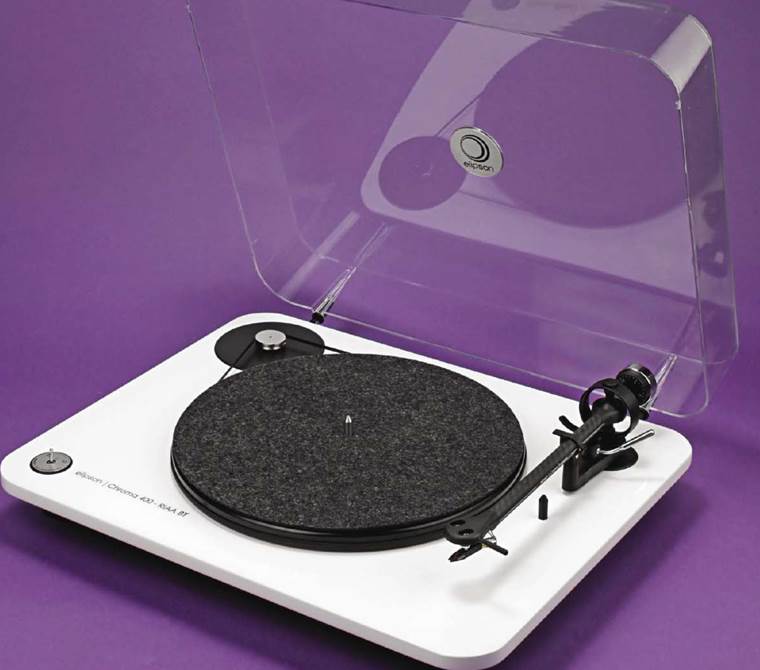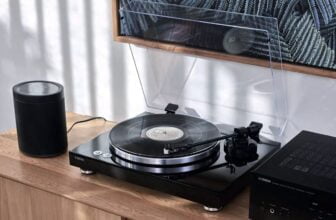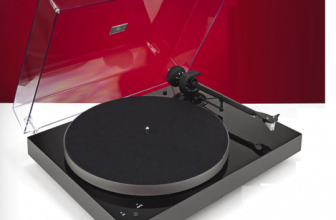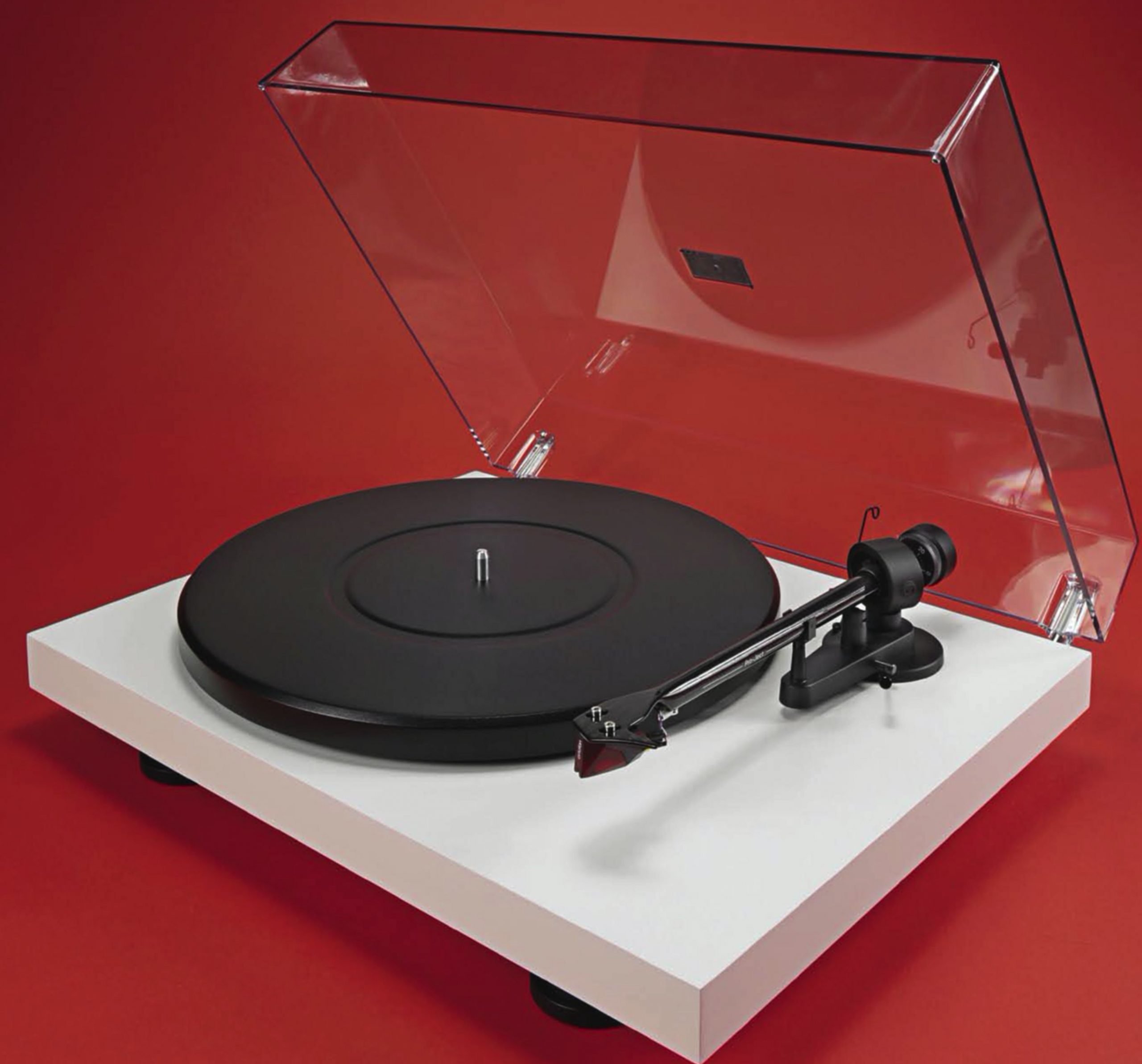Elipson Chroma 400 Riaa Bt Review – Going Digital
The Chroma 400 riaa BT turntable package from Elipson offers hi-res digital and Bluetooth. Noel Keywood investigates. Read our Elipson Chroma 400 Riaa Bt Review.
A major attraction of this turntable is low price – combined with a massive slew of modern features, notable amongst them being a 24bit ADC to output high quality digital. The Chroma 400 RIAA BT I am reviewing here, from elipson (France) has a lot to offer.
Getting into the digital bit straight away – as well as feeding a computer via USB the internal analogue-to-digital convertor (ADC) also feeds a Bluetooth transmitter, for wireless linking to a Bluetooth receiver in the hi-fi, or wherever. Not bad huh? Note however there is no
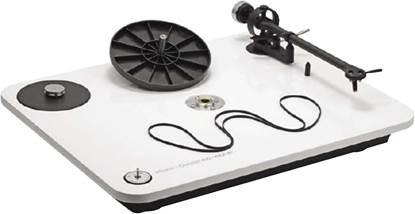
The hub shaft spins on a large ball bearing located at the bottom of the bearing assembly (centre). The long belt passes around the periphery of a pressed steel platter.
digital (S/PDIF) optical output for those with a DAC the other side of the room, counting out use of a long optical cable link – something I find easy to set up and effective. So it’s Bluetooth linking or nothing since USB is not easy to arrange as a live link.
To output digital from a turntable you need a phono stage on-board and this the elipson has, explaining the RIAA suffix. Unusually, there is no bypass output, only a single line-level analogue output for connection to an amplifier. So high quality dedicated (external) phono stages cannot be used. Elipson seem to think their internal stage is perfectly good enough, since they give it an MC (moving coil) option – very unusual. There are budget moving coils that would suit, from Ortofon and Denon for example, but I would suggest a high output moving coil purposed for MM would be the best choice for a turntable like this, for anyone wanting to go down the MC route.
Whatever, the Chroma 400 RIAA BT is very well equipped at the price and I suspect most people will just want to plug’n’play, especially since cartridge changing is not easy due to the arm’s fixed headshell.
Great to plug’n’play – but that

At rear, phono socket analogue outputs from the internal RIAA equalised preamp, for connection to an amplifier’s Aux/Line input. Also a USB port and MM/MC push button (left).
brings up the issue of the cartridge and its sound, which with our version was a budget Ortofon OM10. It’s an old design, price around £ nowadays. And with obviously soft-to-dull sound. This can be a good thing or a bad thing subjectively, as I explain later in Sound Quality. Irrespective, the OM10 isn’t technically accurate. Accurate is the Ortofon 2M Red that comes with the Chroma 400 Carbon RIAA BT model, for which you pay more.
So our review sample came with an old clunker, as it were – but there are subtle benefits, such as a trad. warm sound and cheap stylus replacement. The OM10 tracks well too, so it will not damage records.
The turntable is two speed, 33rpm and 45 rpm, with switch selection between them – no manual belt change needed. That means it has an electronically controlled motor, suggesting accurate speed according to how well it is set up at the factory, and stable speed too. Measurement showed our sample was both accurate and stable – see Measured Performance. Flick the switch from central Off to left or right and the platter will, after a short pause, run up to speed. The platter is a heavy steel pressing, placed over a moulded hub and topped by a felt mat. The short pause is caused by a (deliberately?) loose belt fighting for grip, since the steel platter is heavy. Also steel platters are never used because they are thought to interfere with the magnets in a cartridge. Hmmm…
There are no auto-mechanisms, such as auto-stop at the end of an LP side. Strictly a DIY job. The light, stiff carbon fibre arm must be manually cued down using a damped cueing platform, then cued up at end of side. I hand cue and managed it here, even though the straight, horizontal finger lift is far from ideal – in fact, difficult. Finger lifts must be curved upward for disc surface clearance and to stay on the finger. Sad that this simple shape from SME is rarely used nowadays, even though there’s no cost penalty.
The plinth measures 450mm wide, 380mm deep and 120m high with the clear acrylic lid closed. With it open depth increases to 45cm due to overhang from the lid rear and height increases to 42cm.
The lid can be removed for use in a shelving system with limited clearance between shelves. The feet are not height adjustable. Elipson provide an aluminium puck to place over the centre spindle as a 45 adaptor, for 45s with centre removed for jukebox use.
An external wall-wart power supply unit delivers 12V d.c. via a slim cable 130cm long. No mains earth is needed with such low voltage, avoiding the issue of hum from a mains earth loop. The metal parts should be earthed back to the amplifier to lessen hum induction but elipson don’t fit an earth terminal for this, relying on the earth within the signal leads, so the turntable may need to be connected to an amplifier even when used solely with wireless Bluetooth connection. This depends upon the strength of local hum fields.
Tracking force is applied by a
The Ortofon OM10
budget MM cartridge of our version, synthetic headshell and straight finger lift. An Ortofon 2M Red cartridge with brighter sound is an option.
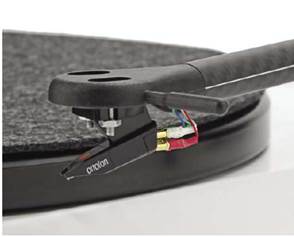
calibrated rear counterweight but it did not screw forward or back in controlled fashion to give accurate tracking force, according to our stylus scales, so an external stylus pressure gauge is needed. There is no adjustable bias compensation, just a pre-applied low outward force that was too low.
The round headshell, lacking parallel sides, made accurate adjustment of cartridge in headshell impossible. Headshells have parallel sides for good reason that elipson don’t understand. Knowing the axis of the headshell is important for tracking alignment, to minimise distortion from tracking error. Bit of a boo-boo here.
Worried I wasn’t hearing the potential of this turntable with the OM10 cartridge fitted I decided to replace it with an Ortofon 2M Black. This gives technically accurate sound balance and has a sophisticated Shibata stylus. I should not have done that! A pin connector fell off one of
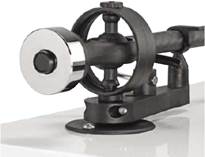
A gimbal bearing arm, but no bias (anti-skating) mechanism.
the fine cables at the solder joint, a magnifying glass revealing a dry joint. I had to perform open-heart surgery with turntable stripped and turned upside down to get at the cartridge connecting cable, using a large illuminated bench magnifier to re-solder the pin connector.
I regretted trying to swap out the OM10 for the 2M Black – sort
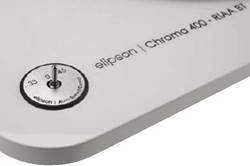
The simple speed change switch – 33rpm and 45rpm, with a central Off position.
of. Sonically, it was a massive change for the better. But the point here is that cartridge changing in a fixed headshell arm like this comes with difficulties and is best left to a dealer who is suitably equipped. And I feel sorry for any dealer so involved; exquisite eyesight and soldering skills are needed, using pro bench equipment.
Build quality and finish were good at the price. There is a lightweight feel but the arm has bearings free of slack and the dust cover moved reasonably smoothly on its simple friction hinges. Weight is a light 5.8kg. Finishes are black, white or red. Options are a Chroma Carbon without phono stage, or Chroma 400 RIAA without Bluetooth. So plenty of choice, our review sample covering the basic package.
SOUND QUALITY
I hooked up the elipson Chroma 400 RIAA BT turntable package to our Creek Evolution I00A amplifier, connected by Chord Company Signature Reference cables to our Martin Logan ESL-X hybrid electrostatic loudspeakers.
As measurement foretold, the budget Ortofon OM10 cartridge had a soft, even dull sound where the words “detail” and “insight” don’t come easily to hand (or mouth). But there was still plenty to appreciate at the price. With Fanfare For The Common Man (Two Countries, One Heart, from HiFi Direct, Italy) trumpets held steady and there was a reasonably good sense of power behind the kettle drum, due to the stiff arm. Another property of a good arm is a wide sound stage with clearly differentiated images across it and here the elipson managed well also.
Spinning Sing Sing Sing (Big Band Spectacular, the Syd Lawrence Orchestra) I was expecting the fast rolling drum work to survive nicely – and it did. Plenty of dynamic punch from cartridge and arm in combination, inevitably without the grip or power of classier (more expensive) set ups. As trumpets and trombones joined the melee though I winced a bit at some upper mid-band harshness, likely from the cartridge stylus. But my ear is used to hearing these LPs from the Shibata stylus of our Audio Technica VM750SH (MM)
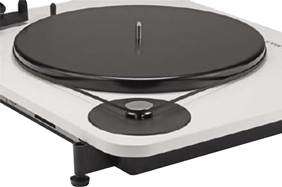
The long belt passes around the periphery of a pressed steel platter.
and OC9X SH (MC) many rungs up from the OM10.
With Tell Me Why from Neil Young (After the Goldrush; a remaster) strummed guitar strings were dull, but the resonant nature of his acoustic guitar’s body came over nicely and vocals were firm and clear centre stage.
Fleetwood Mac’s Dreams (Rumours) sounded obviously dull to the point of being muffled and quite
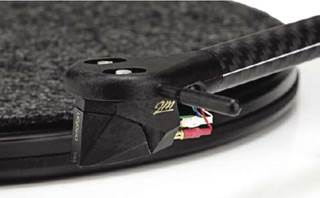
The arm with an Ortofon 2M Black MM cartridge we fitted. Not a price match, but gave a fine sound. Looks good too.
why our recent re-master should not work with the OM10 I am uncertain; it sounded like the stylus was not reading the groove. The bass line was strong but drums lacked punch.
Where a cartridge like the OM10 justifies its existence is with older, worn and noisy LPs like my much played (long ago!) World of Blues Power (Decca, I969) where surface noise, ticks and pops were
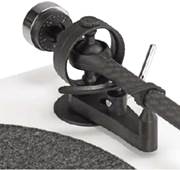
The rear calibrated counterweight did not move smoothly. But the arm clip was excellent.
suppressed to being little obvious.
With Ortofon’s impressive 2M Black MM cartridge in place of the OM10 there was dramatic improvement. OK, it is the same cost as the turntable but it allowed me to hear what the Chroma 400 RIAA BT was capable of. An Audio Technica VM95SH might be a more appropriate choice, also with Shibata stylus but at lower price.
The 2M Black brought not only sonic balance and fine insight, it also brought sturdy bass of the sort Audio Technicas lack. Playing Mobile Fidelity’s 45rpm re-master of Dire Straits Love Over Gold, for example, bass lines were massively powerful, Mark Knopfler deliciously clear centre-stage and cymbals starkly obvious and detailed. I became quite excited listening to this! Running through a wide selection of LPs confirmed superb sound.
With Ortofon’s 2M Black in place I recorded to a MacBook Pro using Audacity, the free (and excellent) software music editor. And the result was very good. The on-board 24bit ADC suffers less of the digital harshness of cheaper 16bit convertors used by most other budget spinners, allowing the sound to better approach that from LP without digital taint – that harsh tin-can sound. If you want to record digitally from LP and not buy a Furutech ADL GT40a, the Chroma 400 RIAA BT is a strong choice, giving a convincing analogue result subjectively.
CONCLUSION
Our Chroma 400 RIAA BT turntable package was limited by the outdated OM10 cartridge in sound quality. With a better cartridge it came alive and worked very well, suggesting the Chroma 400 Carbon RIAA BT with Ortofon 2M Red cartridge is a better choice. But this depends upon buyer sensibilities.
Our package gave a traditional warm sound that was easy going and stylus replacement is cheap. It’s a good starter package and fine value if you want 24bit digital recording, Bluetooth wireless linking and the potential to upgrade to a moving coil cartridge. At the price, a very strong proposition for those wanting trad. sound in 24bit digital form. Within this context the Chroma 400 RIAA BT has little competition and is a top choice.
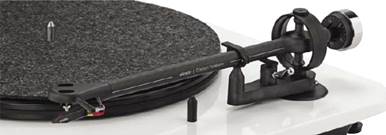
Elipson’s arm is a lightweight but stiff carbon fibre tube.
MEASURED PERFORMANCE
The elipson Chroma 400 RIAA BT was speed accurate and stable under test. The 3150Hz test tone of our DIN 45 545 test disc changed from 3153Hz to 3155Hz – accurate speed (3150Hz) with little speed error about the mean – and with little speed wander as belt drives go. However, there was random variability, where speed would hold at 0.1% wow (good) then suddenly fluctuate to nearly double before settling down again. Our analysis of variation, a long term average, shows basic variation at rotational rate (33rpm/0.55Hz) and some higher components (but below the 10Hz flutter threshold, so technically not flutter). A respectable result, if not quite up to what is now being achieved with modern speed locked motors. A wobbly motor suspension could be the problem, or a relatively slack belt with intermittent grip.
As expected the integral phono stage is sourced from the same factory (in China?) as most others, identified by a strong warp filter that rolls off lower bass, and has a very low output overload value of 1.7V (8-10V is common). This limitation sets input overload at a low 17mV on MM and 2mV on MC at a 1% distortion limit. However, overload is ‘soft’ and progressive so unlikely to be obvious on short term peaks.
Gain values were better than usual from unidentified Chinese factory, x100 (40dB) for MM and x894 (59dB) for MC – appropriate working values. Equivalent input noise measured 0.4muyV for both, suggesting some slight hiss with MC.
Via USB connection the Chroma 400 RIAA BT declares itself as 24bit capable. Full digital level (OdB FS) was reached from 13mV input (MM) and 1.3mV (MC), sensible values. Overload and signal clipping may occur, if only on occasional short term musical peaks. Digital distortion from the internal ADC measured 0.01% at full level and 1% at -60dB. Importantly, the ADC resolved a -60dB signal where budget 16bit ADCs do not, due to the quantisation noise they produce. Frequency response was identical to that from the analogue output, as expected.
The Ortofon 0M10 cartridge – an old design – fitted to our review sample had strongly falling treble above 6kHz pink noise our analysis shows (Adjust+ test disc) so will deliver a classically warm sound. The 0M10 tracks well – no problems here.
At the price, a good result all round with no flaws that will be obvious. NK
Speed accuracy +0.1%
Wow 0.15%
Flutter 0.05%
Total W&F DIN weighted 0.12%
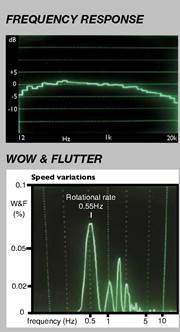
ELIPSON CHROMA 400 RIAA BT
EXCELLENT – extremely capable
VALUE – keenly priced
VERDICT
www.en.elipson.com
